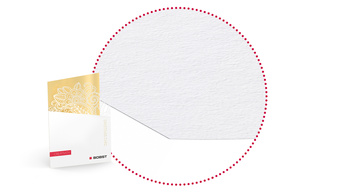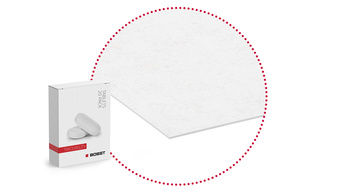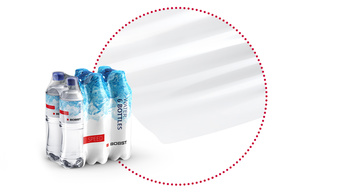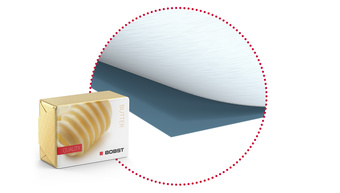Processed materials
BOBST masters all the key technologies required to produce all type of labels efficiently - flexography, digital inkjet, embellishment and finishing. From 1 to 1 million labels, optimize your entire production floor by choosing and building the platform that best meets your customer requirements.
The modular and upgradable All-in-One hybrid solutions provide flexibility and agility to address a wide range of applications with a single equipment. With the highest digital and analogue integration and automation, our digital and hybrid solutions are available in 340 mm and 510 mm print widths in a new design that has been optimized for full modularity, improved operation and servicing.
Paper
Paper is a fibre-based material produced from wood, rags or organic material. The types of paper used in the packaging and graphic arts industries typically use wood and/or recycled paper and board, which is then chemically or mechanically processed to produce cellulose pulp. This pulp is bleached and processed in a paper making machine to produce reels of paper which may optionally be coated or finished to provide a better surface and/or improved visual appearance.
Paper may be between 0.07 mm and 0.18 mm thick, with paper for printing and packaging applications generally being in a range between 60 and 120 gsm. The crossover point between paper and board is normally considered to be around 160 grams per square meter (gsm), as it is only at this level that a fibrous material is likely to be stiff and rigid enough to make a container.
Paper has a wide range of industrial applications including use for the packaging of products as diverse as confectionery and cigarettes, as a component in packaging laminates, and for many commercial print uses.

Carton board
Carton board (also called cardboard, paperboard or solid board) is the name for a range of paper based materials that includes folding box board (FBB, GC or UC), solid bleached board (SBB, SBS, or GZ), solid unbleached board (SUB or SUS), white lined chipboards (WLC, GD, GT, or UD), some unlined chipboards, and certain laminated boards.
To manufacture carton board, fibrous material, either from trees, recycled paper, or a mixture of the two, is turned into pulp. It is then bleached and processed in a board making machine to create a board consisting of one or more layers, which may optionally be coated to provide a better surface and/or improved visual appearance.
The crossover point between paper and board is normally considered to be around 160 grams per square meter (gsm), as it is only at this level that a fibrous material is likely to be stiff and rigid enough to make a container.
Cartonboard is primarily used in the packaging industry to produce all types of folding cartons, but may also be used for graphics applications. For folding cartons the board used will normally be in the range 200 to 600gsm, or 350 to 800 microns.

Film
A film is usually characterized as a thin synthetic resin layer. There are many types of films and their use depends on their physical and chemical properties, which make them especially suitable for a given application.
The most commonly used plastic films are low density polyethylene (LDPE), Polypropylene (PP), bioriented polypropylene (BOPP), and polyester (PET).
Printed film is used for packaging, display materials, stickers, seals, and a wide range of other graphic applications.
Films are generally characterized by their basis weight, expressed in g/m²; and thickness, expressed in microns. For some films it is also useful to know their density, expressed in g/cm3.
The increasing awareness of environmental issues is intensifying research into film substrates derived from renewable sources that are compostable.

Aluminium foil
Aluminum is produced from bauxite, an ore abundant in nature. From the rolling mill, aluminum foils emerge with a natural shiny finish, almost as bright as a mirror, but also can be produced with an as-rolled, satin-like finish called matte.
Aluminum foil has all of the unique functional characteristics of the aluminum alloy from which it is made.
Because of its exceptional barrier properties, aluminum foil is used across a wide range of flexible and other packaging applications to protect foods, drugs, cosmetics, and a lengthy list of other items, most often in combination with other packaging materials.

Self-adhesive & wetglue label stock
Self-adhesive & wetglue label attached or integral part of the package are the mots popular labels. They carry important elements ranging from product information to safety elements. The visual appearance of the labels will vary from industrial to consumer labels which will have very attractive effects such as foiling, embossing, raised inks. Some can included invisible inks and micro texts for security features.
Most common self-adhesive & wetglue label are typically ranging from 60 to 240 gsm. Self-adhesive & wetglue label are the most popular one as they can be applied on a wide range of container.
Self adhesive labels are made up of three layers: a face material, a pressure sensitive adhesive and a release liner. Wet glue labels are mechanically applied before application, usually by the packers.
Wet glue labels are used on various products including bottles and jars container. Wet glue labels are mechanically applied before application, usually by the packer directly. Self adhesive labels use a pressure sensitive adhesive making them very convenient to apply and to adhere to a wide range of substrates.
